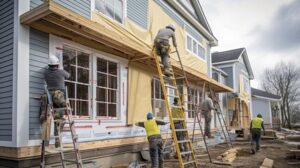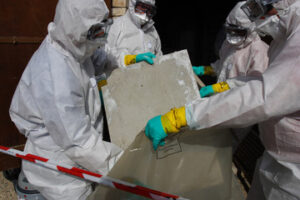Siding is the protective material that covers the exterior side of a wall. It provides the first line of defense against sun, rain/snow, heat, and cold.

It is essential to select the correct type of siding to match your home’s architectural style. You will also want to consider cost, maintenance, and sustainability. Contact Top Notch Roofing/Siding for professional help.
Fiber cement siding is a durable and low-maintenance material that covers the exterior of houses. It is made of a mix of Portland cement (limestone, clay, and iron), sand or fly ash, and wood pulp or cellulose fibers. Some manufacturers also add proprietary ingredients for bonding and durability. The resulting mixture is then dyed and pressed into planks that mimic other materials like brick, natural stone, or wood.
This innovative siding has many benefits that make it a popular choice for homeowners in Kansas. It is highly weather-resistant and can withstand strong winds, heavy rains, hailstorms, and even tornadoes. It is also rot- and insect-resistant, so it will not warp or deteriorate over time. In addition, fiber cement resists fading from exposure to the sun’s UV rays.
It can be painted in a variety of colors to match the homeowner’s style preferences. It is available in a range of textures as well, including smooth surfaces and rough-sawn looks that mimic the appearance of natural wood. Additionally, fiber cement can be installed as soffits and roof eaves, which are critical for attic ventilation and moisture control.
The primary drawback of fiber cement siding is that it can be expensive and time-consuming to install. It is also thicker than traditional vinyl, which makes it more difficult to work with and requires special tools and installation skills. Additionally, it will need to be washed and repainted periodically.
Fortunately, there are several reputable manufacturers of fiber cement siding, and MEI works with a few of them to ensure our customers can find the perfect product for their homes. One such manufacturer is James Hardie, which has a wide selection of siding styles and textures. Some of these include board and batten, shake shingles, and more.
Fiber cement siding is a great option for homeowners in need of a durable and beautiful covering for their homes. It offers a number of benefits that other types of siding do not, including fire resistance, rot and insect prevention, and resale value. Additionally, it is aesthetically pleasing and can be used to achieve a number of different looks for the home.
Vinyl
Vinyl siding is a type of plastic exterior cladding for houses and small apartment buildings. Its popularity stems from its affordability and lack of maintenance needs. It is manufactured to imitate the appearance of wood clapboard, batten board and shakes. This type of cladding can be found on houses and apartments throughout the United States and in some parts of Europe. The cladding can be used on a single story or on multiple stories of a building. The material is also available in a range of colors.
Unlike aluminum and wood, vinyl does not deteriorate over time. It is a durable material that protects a home from harsh weather conditions and extreme temperatures. It is made from polyvinyl chloride (PVC) resin. It is available in a variety of styles, including half-round (scalloped) and cedar shakes. It can also be manufactured to look like shingles and wood grain.
The best type of vinyl for your house depends on its design and location. A traditional style is ideal for a farmhouse or cottage. It can be matched with soffits and accents in a complementary color to enhance the home’s aesthetic. A contemporary home is best served by a neutral palette that feels ageless. It is less prone to color trends and may be easier to sell in the future.
Another drawback of vinyl is that it dents rather easily, even in the heavier gauges. An errant baseball, hail, or power wash can dent the panels, and it is difficult to match the original color. This can lead to moisture infiltration, which rots the wood structure and invites termites and mold.
Vinyl is the most popular siding for new construction, but it is not recommended for older homes with a historical value or in neighborhoods with high property values. While the cost is low, it may detract from a home’s resale value. If you are thinking of selling your house, consider other siding options or at least investigate neighborhood trends to determine if vinyl is the right fit for your home.
A quality installer will take the time to inspect your existing siding and advise you on whether it is still suitable for your home. A missing panel or large cracks are obvious signs that the time for replacement is near. Other indicators include mildew, rot, or mold.
Wood
Wood siding is a popular choice for home cladding because it provides a warm, natural aesthetic to a house’s exterior. It is also relatively durable, and can hold up well to harsh winters or scorching summers without damage. However, it is important to select the right type of wood for your home. The different species vary in their resistance to rot, insects, and moisture, and some require more maintenance than others.
Redwood is a favorite wood siding option for homes because it is very resistant to bugs and rot, and can last decades when properly maintained. However, it can be expensive and difficult to source, especially if you live outside of the western United States.
Pine is another common choice for wood siding, as it is a softwood and easier to access than other species. However, it is not naturally rot-resistant, and can be susceptible to cupping, warping, splitting, or mold and mildew if not treated and protected with the proper care.
Another hardy option is ash, which can be used for both trim and paneling on houses. It is very dense, stable, and durable, and can stand up to heavy rains. However, it does not accept staining very well, and will need a fresh coat of paint every 3-7 years.
Cumaru is a Brazilian wood that is growing in popularity for use as exterior cladding. It has a high-strength to weight ratio, and is able to resist rot and insect infestation. It can also be finished with a low-VOC coating that is environmentally friendly.
Garapa is a sustainable wood that is rapidly gaining popularity for use as home cladding. It has a unique color pigment that helps it to reflect intense sunlight, helping to keep the home cool. Like the Redwoods, it is also a highly resistant wood to insect pests and decay.
While it may not be as durable as vinyl or other types of composite siding, wood is a great choice for homeowners who want to go green with their home. Wood is a renewable resource, and is biodegradable, meaning that it will break down into a compost-like substance over time. It is also more ecologically sound than other options, such as vinyl, which has a large carbon footprint during production and ends up in landfills, unable to decompose.
Composite
Composite siding is a popular choice for homeowners looking for a durable, low-maintenance exterior cladding option. It is also environmentally friendly and can add to the value of your home. However, it is important to weigh the pros and cons of composite siding before making a decision. Its superior protective qualities compared to vinyl and wood make it a more cost-effective choice over the long term.
The main components of composite siding are cellulose fibers, cement, and sand, which give it a hard concrete-like texture. These materials provide a strong and durable finish that is resistant to moisture, rot, mold, and insects. Its durability makes it a great choice for homes in areas with extreme weather conditions. It is also easy to clean and requires minimal maintenance. It is available in a variety of colors and textures, making it easy to customize the look of your home.
Unlike natural wood, composite siding does not split easily, which makes it faster to install than traditional wooden siding. This allows you to save time and money during installation, as well as reduce the amount of debris that is left behind. It is also easier to paint than natural wood, and it can be painted in any color you like.
Another advantage of composite siding is that it is less prone to moisture damage than other types of cladding. It is also more resistant to heat, cold, and wind than natural wood, which makes it a good option for areas with harsh climates. However, it is still susceptible to impact damage from hail and debris during storms.
Composite siding can also be installed in outdoor structures such as sheds, gazebos, and decks. It is more expensive than natural wood, but it offers an attractive and long-lasting finish. It is a great alternative to natural wood, and its longevity means you can enjoy it for years to come. However, you should remember that the lifespan of any product depends on how well it is maintained. Regular cleaning, maintenance, and caulking are essential to protect the integrity of the composite material.
